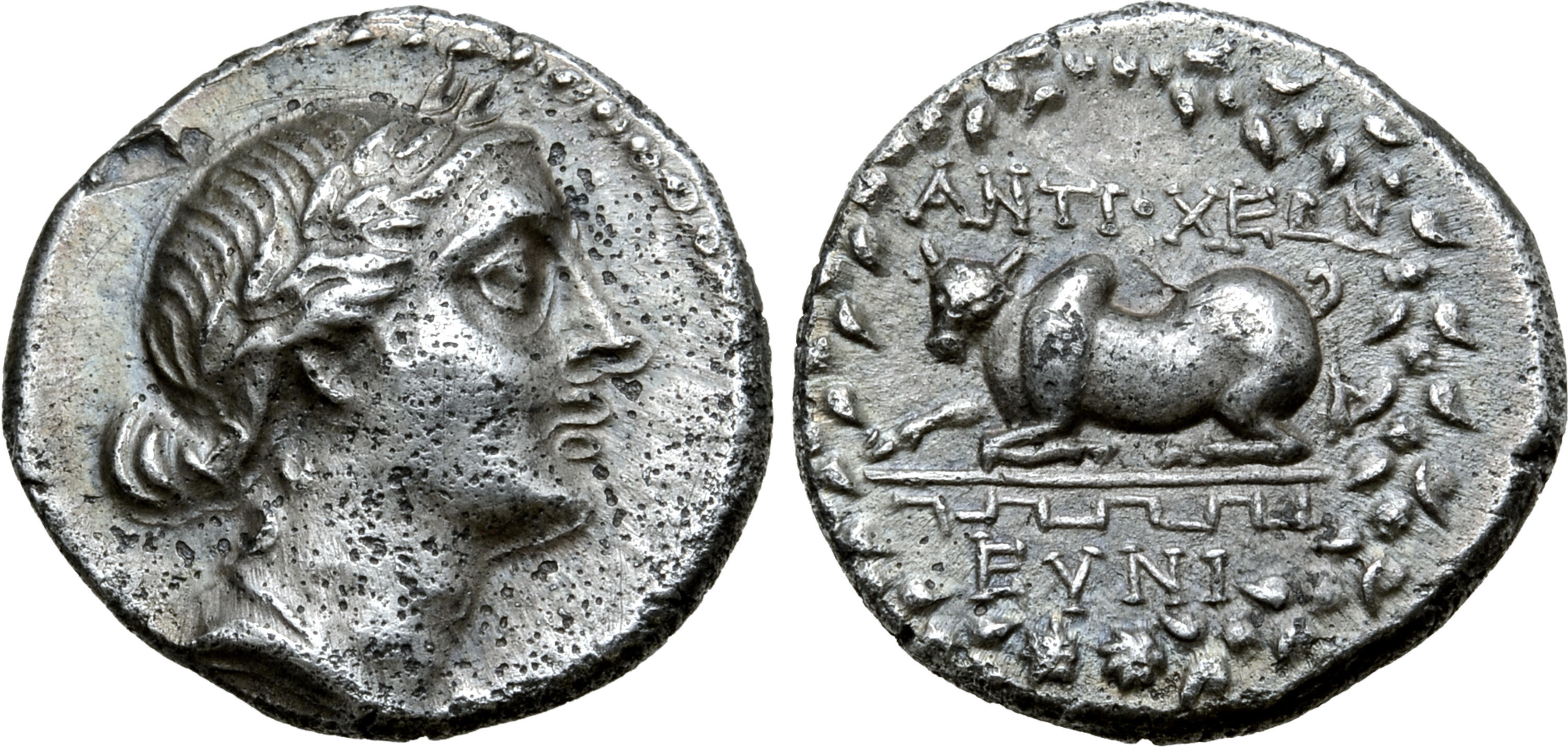Antioch ad Maeandrum, silver, drachms (Apollo/zebu etc.) (100-50 BCE)
From SILVER
100 BCE - 50 BCE Silver 1,392 kg
Description
| ObverseInscription or printing placed on the obverse.: | Laureate and draped bust of Apollo to right |
| ReverseInscription or printing placed on the reverse.: | ΑΝΤΙΟΧΕΩΝ above (Greek).Zebu bull reclining left, maeander pattern above EYNI below, all within Dionysiac wreath of ivy and fruit. |
Mint and issuing power
| MintIdentifies the place of manufacture or issue of a numismatic object.: | Antioch ad Maeandrum | Ancient regionAncient region.: | Caria | Modern countryModern country: Turkey | AuthorityIdentifies the issuing power. The authority can be "pretended" when the name or the portrait of X is on the coin but he/she was not the issuing power. It can also be "uncertain" when there is no mention of X on the coin but he/she was the issuing power according to the historical sources: | Roman Republic |
Chronology
| FromIdentifies the initial date in a range assigned in a numismatic context. | 100 BCE | toIdentifies the final date in a range assigned in a numismatic context.. | 50 BCE | PeriodTime period of the numismatic object.: Hellenistic 323-30 BC |
Physical description
| MetalThe physical material (usually metal) from which an object is made.: | Silver |
Median weightMedian of the weights of numismatic objects (in grams). in grams | 3.80 | DenominationTerm indicating the value of a numismatic object. Examples: tetradrachm, chalkous, denarius.: | drachma |
StandardStandard.: |
Image

S1632 Antioch ad Maendrum drachm.jpg [1]
References
| Die study referencePublication of the study: | Thonemann 20191Thonemann 2019 | ||
| Coin series referenceReference to coin series study: | Sear II2Sear II, n° 4786 | ||
| Coin series web referenceCoin series web references: | |||
Obverse dies distribution
| FrequencyFrequency of specimen in distribution. ᵖ | Number of obversesNumber of obverse dies. ᵖ (o) | % (o) | Number of coinsNumber of coins. (n) | % (n) | Die nameName(s) of the die(s). |
| 1 | 5 | 41.67 | 5 | 19.23 | 2, 5, 9, 10, 12 |
| 2 | 3 | 25 | 6 | 23.08 | 1, 7, 8 |
| 3 | 3 | 25 | 9 | 34.62 | 3, 4, 6 |
| 6 | 1 | 8.33 | 6 | 23.08 | 11 |
| Total | 12 of 12 | 100 | 26 of 26 | 100.01 |
Reverse dies distribution
no distribution is available
Quantification
| Number of obversesNumber of obverse dies. ᵖ (o) | 12 | Number of singletons (o1)The number of singleton coins. ᵖ | 5 |
| Number of reverse diesNumber of reverse dies. (r) | 12 | Number of coinsNumber of coins. (n) | 26 |
| Coins per obverse dieNumber of coins per obverse die. (n/o) | 2.17 | Coins per reverse dieNumber of coins per reverse die. (n/r) | 2.17 |
| Reverse per obverse ratioRatio of obverse dies divided by reverse dies. (r/o) | 1 | Percentage of singletons (o1)number of coins (n) divided by the number of singletons (o1) ᵖ | 41.67 % |
| Original number of dies (O) (Carter 1983 formula)The estimation of the number of coins according to Carter 1983 ᵖ | 18.32 | Coins struck if 20,000 as average productivity per dieCoins made if the average productivity for obverses (according to Carter) is 20,000. ᵖ | 366,400 |
| Original number of dies (O) (Esty 2011 formula)The estimation of the number of coins according to the singleton formula in Esty 2011 ᵖ (O) | 22.29 | Survival rate if 20,000 as average productivity per dieSurvival rate if average productivity is 20,000. ᵖ | 0.00007 |
| Coverage (o = % of O) (Esty 1984 formula)Esty 1984 - coverage (% of O) ᵖ (o = % of O) | 80.77% | Die productivity if survival rate 1/2,000Average productivity if survival rate is 1/2,000. ᵖ | 2,838.43 |
| Weight of silver (in kg) if 20,000 coins per die (O = Carter formula)Carter 1983 * Median weight * 20000 (*10 if gold or electrum) ᵖ | 1,392 kg <br /> 1,392 kg | Die productivity if survival rate 1/5,000Average productivity if survival rate is 1/5,000. ᵖ | 7,096.07 |
Remarks
Most likely one single workstation Likely military